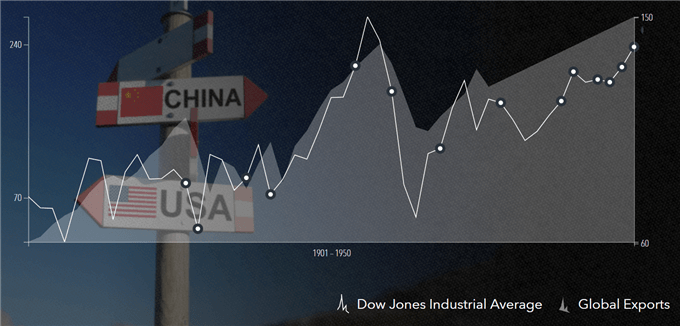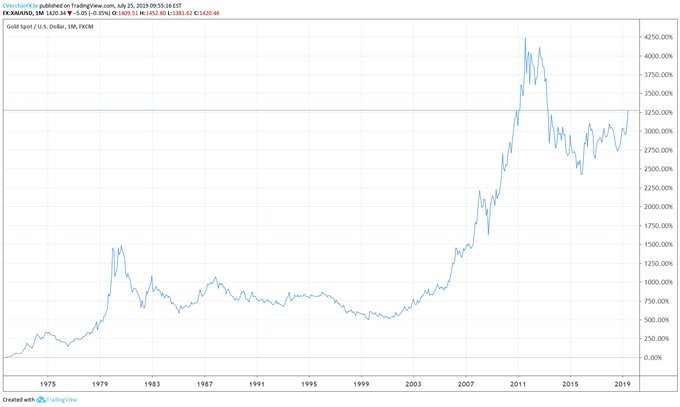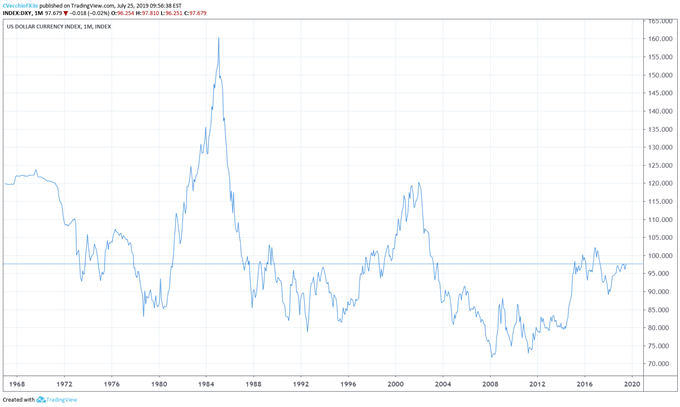The Lessons of Bretton Woods Talking Points:
- The 75th anniversary of the Bretton Woods conference was at the end of July, and the concerns that Bretton Woods tried to address back in 1944 are reasserting themselves as significant threats to the global economy in 2019.
- As lessons from Bretton Woods are forgotten, the US-China trade war represents a true existential threat to the post-World War II international trade order, and in turn, the globalized economy that has grown out of the ashes of history.
- The US Dollar may be facing a long-term structural disadvantage as the rise of China and other major economies in Asia at a time when western economies are struggling; calls to end US Dollar hegemony as the world reserve currency will only grow louder.
Looking for longer-term forecasts on Gold and Silver prices? Check out the DailyFX Trading Guides.
75 years ago this July, policymakers from around the world gathered in a quaint New Hampshire town called Bretton Woods. With the global economy at a nadir thanks to the devastating impact of World War II, policymakers were keen to take advantage of the crisis, a significant turning point in human history: a new framework could be developed that would prevent another conflict on the scale of World War I or World War II from ever taking place again.
Given the state of affairs for the global economy, particularly the rise of protectionism vis-à-vis tariffs, it’s a good time to remember why the Bretton Woods system was agreed upon in the first place, and why the lessons of the two World Wars may have been forgotten. In turn, the consequences for the US Dollar and the global economy over the next several years could be extremely destructive.
Bretton Woods Has its Roots in the World Wars
World War I saw a significant collapse in international trade as budding trade liberalization came to a sudden halt. Major stock exchanges across the world shuttered starting in 1914. As wartime trade protection measures are unwound as the Great War ends in November 1918, the League of Nations comes into existence in 1920.
In 1920, soon after the League of Nations is created, a brief global economic recession hits, giving pause to efforts by the League of Nations to foster greater trade liberalization. In 1927, the League of Nations organizes the first World Economic Conference to outline a multilateral trade agreement.
1920s and 1930s: Great Depression, Tariffs, & Fascism
In 1930, the Great Depression begins. Efforts taken by the League of Nations in 1927 prove meaningless in the face of global economic uncertainty. Nationalism begins to rise again after staying quelled during the 1920s. Major economics begin raising tariffs to try and maintain favorable balance of payments and stable fiscal situations.
The Smoot-Hawley Act of 1930 was a precursor to World War II, just as the Tariff of Abominations of 1828 was a precursor to the US Civil War. This was the last time that America embraced a protectionist policy, under President Herbert Hoover, levying taxes of up to 50% on imported goods. It was widely considered to be a blundering mistake that crippled global economic activity and helped accelerate the decline in the Great Depression.
The global trade freeze only ended when Congress passed the Reciprocal Trade Act of 1934, which gave the President, then FDR, the power to negotiate bilateral trade deals with other countries without Congressional approval. However, by that time that global economy had been broken for long enough to give rise to ethnic-nationalist populism in Europe.
From 1939 to 1945, World War II produces another catastrophic collapse in international trade. But the cost is not just borne by trade balances; human and physical capital is obliterated in Europe.
A Brief History of Trade Wars: 1900-1950

Resolving the Nation State-Globalization Conflict
From a certain perspective, there is an argument to be made that both World Wars were rooted in globalization. As the world economy became globalized in the late-19th and early-20th centuries, the world’s largest economies found themselves needing to assert military dominance in order to secure economic security. Requiring more resources from outside their national borders to fund economic growth, the world’s major economies, situated in Europe at the time, faced little choice but to engage in conflict when forced confront a zero-sum economic system.
An understanding soon began to emerge that the lack of an effective international framework for cooperation facilitated conflict between major economies; the world needed something with more teeth than the League of Nations if a third World War was going to be avoided.
1944: Bretton Woods, New Hampshire
In the waning days of World War II, when it becomes clear that the tides of fascism will be beaten back from Europe’s shores, policymakers across the world begin to discuss ways to ensure cooperation among the world’s largest economies in order to avoid another cataclysmic conflict. Descending on the Mount Washington Hotel in Bretton Woods, New Hampshire, officials from the United States, Canada, Western Europe, Australia, the Soviet Union, and China agreed to a framework of monetary policy management as well as establish rules for commercial and financial relations – the “Bretton Woods” agreement. Important groundwork was being laid to integrate post-war Germany, Japan, and Italy into the new global economic order.
There were two key pillars that the Bretton Woods system was based on. The first was political: the USSR agreed to allow Western European countries return to American-stylized capitalism after World War II. This pillar was cemented when Stalinists in France and Italy supported pro-capitalist governments in the immediate aftermath of World War II. The second pillar was economic: the global economy would be remade in the United States’ image, which at the time was that of a manufacturing behemoth, accounting for 50% of global manufacturing in 1945.
The Bretton Woods system, agreed upon in July 1944, attempted to resolve the conflict between the nation state and an increasingly globalized economy by instilling a framework of cooperation that reduced the need for the world’s major economies to assert military dominance in order to achieve their desired economic goals. Bretton Woods institutions include the World Bank and the International Monetary Fund, whose initial efforts were to rebuilding the post-World War II global economy and promote international economic cooperation.
Keynes Can’t Save British Imperialism, US Dollar Hegemony Arrives
The Bretton Woods system enshrined an obligation for each country to adopt a monetary policy that maintained its exchange rates within one percent by linking each country’s currency to gold (i.e. the “gold standard”). The UK’s representative at the conference, famed economist John Maynard Keynes, attempted to ensure that the British empire would remain at the center of this new system, proposing a “bancor” international currency in an attempt to preserve British influence.
Somewhat ironically, the calls for cooperation around an international currency failed, and the US Dollar was thus enshrined as the de facto world reserve currency when the gold standard established that gold would be priced at $35/oz and could be exchanged for US Dollars at any point in time; the greenback was ‘as good as gold.’
Gold Price Historical Chart: Monthly Timeframe (1971 to 2019)

1971: Nixon Takes US Off the Gold Standard
By the late 1960s, the Bretton Woods system was under pressure as the rapidly expanding post-World War II European economy strained relations with the United States. Flush with excess capital (vis-à-vis higher taxes revenues), European governments were recycling their US Dollars back into gold, provoking a massive drawdown in US gold reserves. In a sense, under Bretton Woods, global growth was being financed at the United States’ expense.
On August 15, 1971, US President Richard Nixon announced that the US would no longer honor accept US Dollar conversion to gold, ending US participation in the “gold standard.” In doing so, US President Nixon was attempting to maintain American influence over the global economy. As history shows, the removal of the “gold standard” was terrible for the US Dollar, with the DXY Index losing -23% of its value in the immediate two years following the decision – it hastened the decline of the US Dollar as the centerpiece of the global financial system
Read more: The History of Forex
US Dollar (DXY Index) Historical Chart: Weekly Timeframe (1967 to 1976)

But as other countries adopted American-stylized capitalism in the post-World War II years, the United States lost its perch as the preeminent manufacturing economy of the global economy: after peaking at 50% in 1945, the US share of global manufacturing output is now around 18%.
Seeds of US-China Trade War are Planted
In 2019, both the Chinese and European shares of global manufacturing output are greater than that of the United States (approximately 20% each). Much of the US-China trade war is predicated around the belief that China has unfairly take advantage of the US-led international trade order. In a sense, the seeds of the US-China trade war were planted when the Bretton Woods system of international cooperation began to erode starting with the US departure from “gold standard” in 1971.
2019: Lessons of Bretton Woods are Forgotten
With the US-China trade war raging, it’s clear that the lessons of the gathering in Bretton Woods, New Hampshire 75 years ago have been forgotten. As US President Donald Trump rages against the United States’ largest trading partners for unfair trade practices, he continually lampoons China and the European Union for competitive currency valuations versus the US Dollar. The use of tariffs by the US as a protectionist measure harkens the demise of the US-led international order.
But for western economies, the collapse of the Bretton Woods system of international cooperation may be a harbinger of things to come. "The Bretton Woods order as we know it has reached its limits," French Finance Minister Bruno Le Maire recently said. "Unless we are able to reinvent Bretton Woods, the New Silk Roads [China’s efforts to fund infrastructure development from Asia to Europe] might become the new world order.”
US Dollar (DXY Index) Historical Chart: Monthly Timeframe (1967 to 2019)

Who Benefits if US Dollar Loses Hegemony?
The Bretton Woods system, much to the chagrin of John Maynard Keynes, enshrined the US Dollar as the world’s reserve currency, taking the mantle from the British Pound – this is why Keynes wanted the “bancor” currency. Having the power of the global unit of account – all oil contracts are settled in US Dollars, hence the “petrodollar,” for example – the US Dollar (and thus, the US economy) is afforded a level of privilege that few others enjoy.
But the underpinning of this privilege has been the fact that the US economy has maintained at least a 25% share of global GDP in the post-World War II era. That countries in Asia and Africa are growing faster than their western counterparts means that there will be an inevitable shift of power over the coming decades. If the Bretton Woods institutions fails to evolve in a manner that allows for greater cooperation among emerging market economies, it’s likely that China’s One Belt, One Road initiative becomes a new standard for global cooperation.
The US-China trade war is yet another episode in the history of the global economy where the old power is struggling to contain a rapidly growing new power. Perhaps the United States will be as helpless in preserving the US Dollar’s role at the center of the global financial system as John Maynard Keynes and the British were in 1944.
But it shouldn't be understated or undersold: the US-China trade war is a threat to US Dollar hegemony; indeed, it is a threat to entire post-World War II order conceived in a quaint New Hampshire town known as Bretton Woods.
FX TRADING RESOURCES
Whether you are a new or experienced trader, DailyFX has multiple resources available to help you: an indicator for monitoring trader sentiment; quarterly trading forecasts; analytical and educational webinars held daily; trading guides to help you improve trading performance, and even one for those who are new to FX trading.
--- Written by Christopher Vecchio, CFA, Senior Currency Strategist
To contact Christopher Vecchio, e-mail at cvecchio@dailyfx.com
Follow him on Twitter at @CVecchioFX
View our long-term forecasts with the DailyFX Trading Guides






